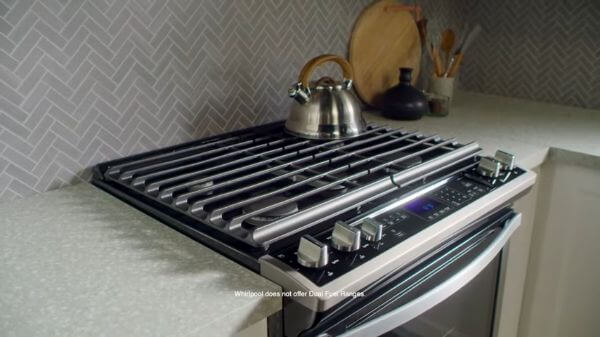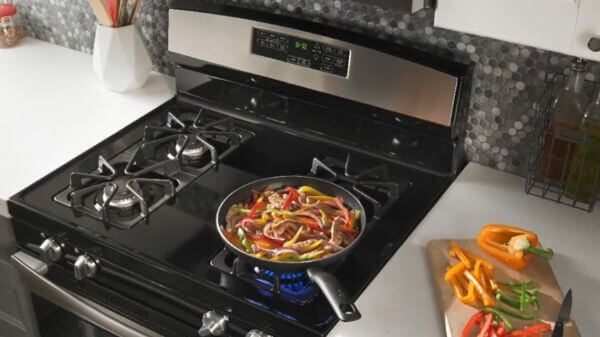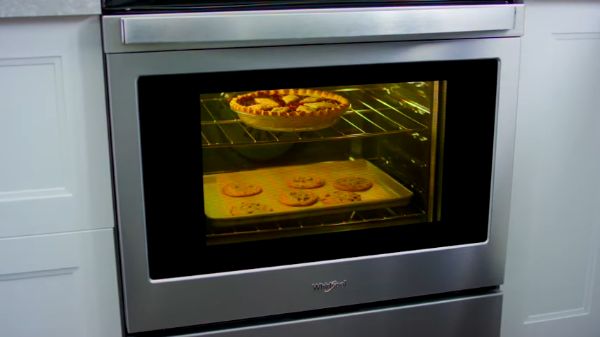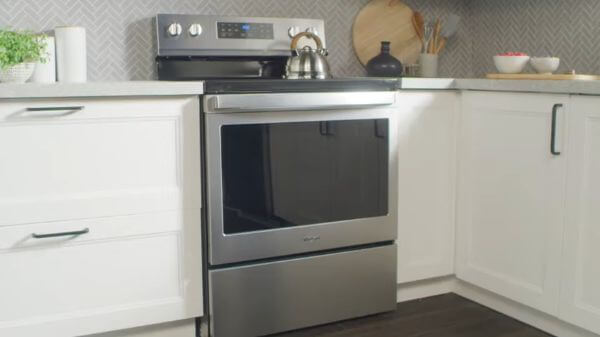The range, which combines a cooktop and an oven, is an important part of every kitchen. It’s where parents teach their children to cook and bake, and where friends and family get together to cook and share recipes.
When buying a new range, the following are the most important factors to consider:
- type of fuel
- cooktop heat options
- control placement or configuration
- size
- performance
- features
- finishes
Table of Contents
Types of Fuel
There are two types of ranges: gas and electric.
Cooking time and results are affected by the type of fuel used.
Gas ranges are typically more energy efficient and cost less to operate than electric ranges.
This is because gas uses less energy than electricity to power your range. Gas ranges give instantaneous and precise heat.
This enables for more exact cooking, allowing you to get the most out of any recipe.
However, because they must be linked to a natural gas line, gas ranges require professional installation.
If your property does not have a gas line, you can purchase liquid propane conversion kits for certain gas ranges.
Electric ranges are often inefficient when compared to gas ranges.
Because electricity takes longer to reach the appliance, they can be more expensive to run.
Electric ranges, on the other hand, are easier to install because they only require a regular 240 volt socket.
Electric ranges heat at a lower temperature, resulting in more consistent and consistent outcomes.
Some electric ranges are also easier to clean. They have a smooth glass cooktop that can be wiped clean without having to remove parts or grates.
Dual fuel ranges, as the name implies, combine gas and electric components to provide optimal cooking and baking options.
The cooktop is gas-powered for accurate cooking, while the oven is electric for consistent temperature throughout the cavity.
Dual fuel ranges are costly, yet they are frequently preferred by professional and experienced cooks.
Different types of heat are used on cooktops. Let’s look at your choices.
Gas Cooktops
Professional cooks choose gas cooktops because of their speedy heating and accurate burner control. They can be fuelled by natural gas or propane.
British Thermal Units (BTU) are used to measure the output of gas burners.
A larger BTU production translates to more heat. This is critical for cooking techniques that demand 15,000 or more BTU, such as searing.
A lower BTU output of 5,000 or fewer means less heat, which is important when melting butter, for example.
Cleaning many gas cooktops is more challenging.
The easy-to-lift hinge grates offered on select Whirlpool gas ranges make it easier to clean spills and stains.
Without completely removing the grates, you can gain access to the cooktop.
Electric Cooktops
Electric cooktops are less expensive than gas cooktops.
Indirect heat is used to heat cookware and cook food on a radiant electric cooktop.
It may have twin or triple elements with various rings to provide the appropriate amount of coverage for your pants size and power requirements.
This style of cooktop is simple to clean due to its smooth surface.
Induction cooktops send heat directly into your cooking vessel rather than passing it through the cooktop service and then the vessel. Induction cooktops are most efficient when used with the proper cookware.
An induction cooktop’s burners don’t stay hot for long after they’ve been switched off.
Spills are easy to clean thanks to this and their flat surface.
If you buy an induction range, you’ll also need the appropriate cookware.
Cookware with a high iron or steel content and a flat bottom will be compatible.
The magnet test is an easy approach to discover compatible cookware. An induction cooking surface can be utilized with a magnet attracted to the bottom of a flat-bottom pot or pan.
The most affordable choice is usually an electric coil burner range.
You can use any sort of cookware with it, but it takes longer to heat up and cool down than, say, induction.
Freestanding vs Slide-in
Let’s look at the differences between freestanding and slide-in ranges.
One may be better suited to your kitchen layout and aesthetic than the other.
The fundamental distinction between freestanding and slide-in ranges is whether or not they have a backguard and where the controls are located.
Slide-in
Because the controls are on the front of the range, slide-in ranges are also known as front control ranges. No backguard is present.
They blend in with your countertops to give you a finished look.
A slide-in range is an excellent choice for a kitchen island or against a wall with a continuous backsplash because of its sleek appearance.
Unfinished or completed sides are available on slide-in ranges. Slide-in ranges with completed sides can be placed almost anyplace in the kitchen.
With the FIT system limited guarantee, you can choose your next slide in range with confidence.
Whirlpool guarantees that your 30 inch slide-in range will fit into existing cabinet cutouts that are 30 inches wide, 24 inches deep, and 36 inches tall.
If you’re unhappy with the fit of your range, Whirlpool will pay up to $300 to have the depth of your countertop cutout professionally altered.
Freestanding
Because the controls are positioned on the range’s backguard, freestanding ranges are also known as rear control.
The backguard protects your kitchen walls from spills and splashes in addition to housing controls.
Freestanding ranges are less expensive than slide-in ranges at the start.
They have polished side panels and may be placed in any location in your kitchen.
Size
Size is also a significant aspect.
Choose a range size that matches your family’s needs while also fitting within your kitchen’s layout and dimensions.
If you live in an apartment or condo, a smaller size may be preferable.
The usual width of smaller ranges is 20 to 24 inches. In general, they function similarly to larger ranges. Their sole distinction is that they have a lower cooking capacity.
The width of larger size ranges can range from 30 to 60 inches.
Before making a purchase, double-check that the size of the appliances you desire will fit in your kitchen.
If you want more power and interesting features, choose a commercial style range.
Commercial style ranges, commonly referred to as professional style ranges, are popular among serious cooks.
These strong ranges may produce up to 15, 000 to 20, 000 BTUs per burner, compared to a regular non-commercial style range’s average of 5, 000 to 7, 000 BTUs per burner.
As a result, you’ll be able to fry, cooking, boil, and broil like a pro in no time.
Dual fuel choices are available on some commercial style ranges, allowing passionate cooks to obtain the precision of a gas cooktop and the consistency of an electric oven.
Modern commercial ranges can be up to 60 inches wide, but they can also be smaller.
You can select from a variety of cooktop burner options, including a griddle, grill, or both, as well as a sealed, open, or induction top, depending on the model.
Make sure your kitchen is equipped to handle a huge appliance and has a good ventilation system before making a purchase.
Features
The following stage is to think about features when you’ve decided on fuel type, configuration, and size.
Do you wish to increase your cooking and baking experience with even more convenience and functionality, or are you looking for basic range features?
Here are some features that you might find appealing.
A single or double oven range is available.
A twin oven range allows you to cook various items at different temperatures at the same time.
Cleaning systems are offered in three types, similar to wall ovens.
Hand-cleaning is required for manual or standard clean ovens. Some stains may require the use of cleansers.
To incinerate any spills or food, self-cleaning ovens use a high heat cleaning mode of around 800 degrees Fahrenheit or 400 degrees Celsius. During this time, the oven door locks.
A self-clean cycle takes two to six hours on average, and you may need to wipe off any leftover food particles.
To create residue-lifting steam, steam cleaning ovens employ low heat and additional water. This method is faster than manual or self-cleaning.
However, any remaining residue will have to be physically removed, potentially with a chemical cleaner.
AquaLift technology is available on some Whirlpool ranges, allowing you to clean the oven in under an hour. Simply add water, run the cycle, and wipe clean with a damp sponge when it’s finished. It has no odor and uses low heat.
Always read and follow the use and care instructions for your appliances before starting any task; they should be your primary source of information.
Convection ovens have a fan that circulates air around the oven cavity to evenly distribute heat for quick and precise baking. There’s no need to rotate that cookie tray, and you won’t have to worry about crispy edges on your cakes.
Both gas and electric ranges have convection capabilities. Convection heats up quickly as well. This means less time is spent preheating.
Convection can be divided into two types.
To deliver even internal heat, fan convection typically uses one fan at the back of the oven.
True convection uses a fan as well, but it also includes a third heating element to assist circulate uniform temperatures for more consistent roasting and baking than typical thermal cooking.
True convection is available on several Whirlpool ranges. The bow tie design and convection fan assist you in getting the desired outcomes from your cooking and baking recipes.
A warming drawer is available on several ranges. A baking drawer is another name for it.
This separate compartment gives additional space for keeping dishes warm until the rest of the meal is ready to be served at a low, consistent temperature.
Some warming drawers also include a slow cook setting and can be used to aid raise bread dough.
On particular ranges, Wi-Fi connectivity is an intriguing high-tech feature. It allows you to use an app to control the appliance.
You could, for example, preheat or modify cooking modes and temperatures from a distance.
The Finish
Let’s address one final factor, the finish, now that we’ve covered many of the technical and performance factors of picking a range.
Ranges are available in a variety of finishes, including white, black, and fingerprint-resistant stainless steel, to match the majority of kitchen appliances.
Select a finish that complements the style and design of your kitchen.
The appropriate range can assist you in creating delectable dishes while also ensuring that you get food on the table on time.
We hope that this guide has helped you select a range that meets your needs and exceeds your expectations.




